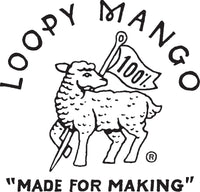Pattern Key
Conventions
Parentheses ( ) = Most often used to present multiple sizing options and/or instructions. If a pattern offers multiple sizes, numbers in the pattern will be given first for the smallest size with numbers for larger sizes following in parentheses.
- Example: You are following a pattern with three sizes: Small, Medium, and Large. They will be written in the pattern as Small (Medium, Large). Numbers in the pattern for each size will be written accordingly, in cases such as:
- Cast on: The pattern reads as: "Cast on 6 (8, 10) stitches." This means you will cast on 6 stitches for size Small, 8 stitches for size Medium, or 10 stitches for size Large.
- Stitch number: The pattern reads as: "Row 1: K6 (8, 10)." This means you will knit 6 stitches for size Small, 8 stitches for size Medium, or 10 stitches for size Large.
- Row number: The pattern reads as: "Rows 1–10 (12, 14): K6 (8, 10)." This means you will follow the instructions for 10 rows for size Small, 12 rows for size Medium, or 14 rows for size Large.
Asterisk * = Repeat the directions following the asterisk as many times as indicated.
- Example: *K1, P1; repeat from * to end of row = Knit 1 stitch and purl 1 stitch, repeat this sequence to the end of the row.
Square brackets [ ] = Repeat the directions enclosed in the square brackets as many times as indicated.
- Example: [K1, P1] 4 times = Knit 1 stitch and purl 1 stitch, repeat this sequence 3 more times.
Gauge (tension) - We always provide a gauge in our patterns. This indicates how tight or loose you should knit your piece. If our gauge says 4sts for 3'' and 4 rows for 2'', that means 4 stitches should fit in 3'' and that 4 rows should fit in 2'' measurement. If you have 5 stitches in 3'' that means you are knitting a little bit too tight, or 2 stitches in 3'' - a little too loose.
C1 = Color 1 (C2 = Color 2, etc)
C4B (Cable 4 Back) = Slip next 2 stitches onto cable needle and hold at back of work, knit next 2 stitches from left-hand needle, then knit stitches from cable needle
C4F (Cable 4 Front) = Slip next 2 stitches onto cable needle and hold at front of work, knit next 2 stitches from left-hand needle, then knit stitches from cable needle
ch = chain stitch in crocheting
K = Knit
K1 = Knit 1 stitch
K1B = Knit 1 below (used in Fisherman Rib Stitch)
K2tog = Knit 2 stitches together
KFB = Increase by knitting through front and back of stitch
M1 = Increase by making 1 stitch
ML = Make Loop stitch
P = Purl
P1 = Purl 1 stitch
P1B = Purl 1 Below (used in Fisherman Rib Stitch)
P2tog = Purl 2 stitches together
psso = Pass slipped stitch over
pm = Place marker
Rep = Repeat
Rnd = Round
RS = Right side of work (outside of garment)
SL = Slip stitch
ssk = slip, slip, knit
Sts = stitches
St st = stockinette stitch
T3B (Twist 3 back) = Slip next stitch onto cable needle and hold at back of work, knit next 2 stitches from left-hand needle, then purl stitch from cable needle
T3F (Twist 3 front) = Slip next 2 stitches onto cable needle and hold at front of work, purl next stitch from left-hand needle then knit stitches from cable needles
WS = Wrong side of work (inside of garment)
YO = Yarn over - wrap yarn around right needle

